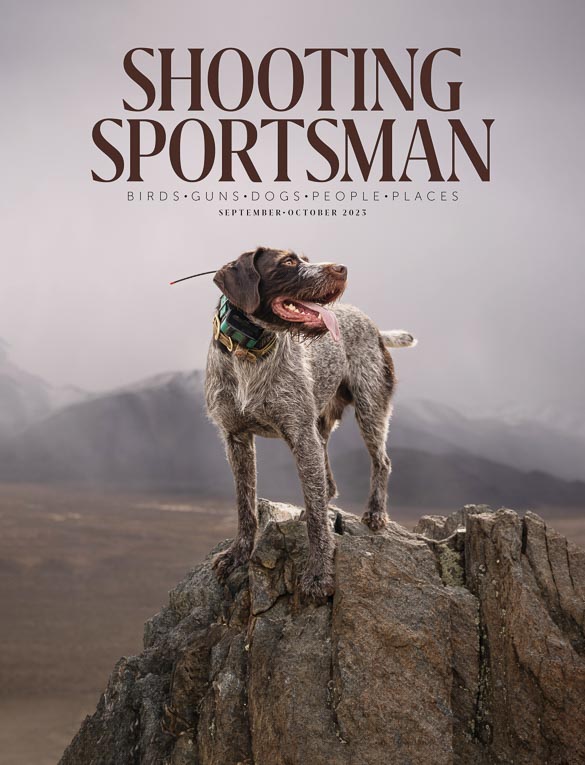As bird hunters, we all appreciate the beauty of a classy pointing dog that hunts in control, sticks every point and effortlessly retrieves downed birds. “I want one just like that!” has no doubt been uttered countless times by dogless hunters fortunate enough to have watched a well-trained, experienced grouse or pheasant dog at work.
Once you have that picture in your mind, it’s easy to become fixated on the breed you were so impressed with. You should get the dog that you think will make you happy. That said, I want you to consider several variables that go far beyond breed.
Decisions about dogs are way more important than decisions about guns or gear. That is doubly true if you have a family. If the pup turns out to lack natural ability and hunting instincts or if it’s not a good fit for the style of hunting you prefer, once your spouse and kids are attached to it you won’t have any choice but to put up with the dog for the next decade.
Except for diehards and guides who own multiple dogs, the reality is that most hunters get to own only five or six dogs in a lifetime. Make your choice count.
Straight Talk About Breeds
I’d be at risk of creating a sticky wicket for myself if I started applying labels to breeds, so I’m not going to do that. The bottom line is that how a dog works is as important as its breed. For the purposes of this article, “how a dog works” means how much the dog ranges (hunts close vs. far away) and how it handles birds (points at a distance on a sliver of scent vs. needing a close-up noseful before committing to a point). More on this later.
While some of a dog’s behaviors have to do with training, excellent performance starts with bloodlines. So Rule No. 1 is to make sure you know the dog’s parents. Study the pedigree, and consult with hunters who own dogs from the same line. Then, even after doing your homework, insist on seeing firsthand how the parents work.
Some hunters want what I call “offshoot breeds,” because those dogs are different from what everyone else has. I recommend using caution here. If you’re turning up your nose at the “common” breeds, you’re overlooking the fact that those breeds are more populous and available from more breeders. Therefore, the odds of finding a good match with one of these breeds are higher.
If you’re picking a particular breed based on its color or because a breeder has convinced you that his or her “designer” or “rare” pointing dog is superior to those boring ol’ English setters, pointers and German shorthairs/wirehairs (and other well-regarded breeds with long track records of excellence), you’re taking needless risks.
What Are Your Priorities?
If you aren’t clear with yourself about why you want a pointing dog, you’re in danger of making the wrong decision. It’s not much different than walking into a hardware store to purchase a hammer. You need to match the hammer to the project. Framing? Ball-peen? Mallet? Roofing? Claw? Sledge?
Where it can get tricky is if you need one hammer to do multiple tasks. Well, the same applies to dogs. Do you want a dog that can hunt the deep woods but also retrieve ducks? Or are you a specialist who hunts only wild pheasants and sharptails on the prairie?
If you simply say, “I want a German shorthair,” you’re not narrowing it down far enough. I’ve seen shorthairs that wouldn’t get any farther away than most flushing dogs, and I’ve seen others stretch the horizon like field-champion pointers.
What I said earlier about the parents also ties into choices about the way a dog works. You should look for a pup or started dog from parents that have hunting styles that suit you.
One example (and admittedly a generalization) would be to compare the attributes of different lines of English setters. Ryman and Hemlock setters have long been popular in New England for hunting relatively small coverts. But for hunting the massive state- and national-forest lands in the Great Lakes states, a smaller-framed, faster English setter might be preferred.
What’s your age, fitness level and temperament? If you had a big room to paint and the option of using a sprayer, a four-inch brush or a two-inch brush, which would you use? For some, the two-inch brush would be preferred because they would want to paint slowly and methodically and wouldn’t want to have to go over any areas twice. The gundog equivalent of the two-inch brush would be a close-working dog. Others might want to get the job done as quickly as possible and go with the sprayer. That would be a big-running dog.
A Beautiful Symphony
These days there are wingshooters who hunt exclusively on preserves. Others refuse to hunt anything but wild birds. Then there are some who do a bit of both. Regardless of whether you think the ideal dog is methodical, a speed demon or something in between, there is one thing we can all agree on: When you take on the challenge of bird hunting with a pointing dog and all goes right, it’s like experiencing a beautiful symphony.
It takes a lot of time, work and discipline to achieve that goal. Give yourself an advantage by envisioning what you need and what you expect your dog to do. That will help in making the right choice—and ensuring you’re in for a decade or more of great hunting experiences.
Buy This Issue / Subscribe Now





